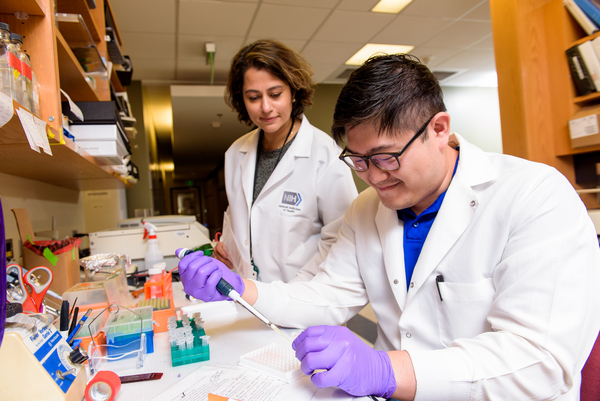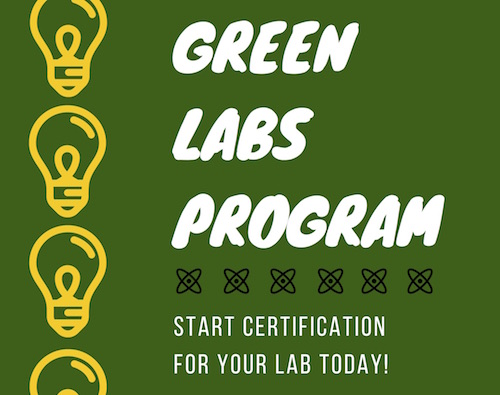Written by Hannah Weems

UAB is the state of Alabama’s largest employer, supporting one of every 31 jobs statewide, with an annual impact of more than $7 billion. UAB is also an R1 Institution, ranked 20th nationally in NIH funding. In turn, UAB is also the largest electricity consumer in the state and generates more than 2,000 tons of landfill waste annually, according to UAB Sustainability. A portion of this waste comes from the necessary work of UAB’s nearly 2,000 laboratories, but researchers have the ability to reduce this impact by becoming certified in UAB’s Green Labs Program.
The goal of the Green Labs Program is to reduce the use of energy, water, material goods, and hazardous chemicals in UAB labs without compromising research integrity or safety. The program provides tips for better sustainability within labs and a recycling service to pick up nontoxic batteries, Styrofoam, paper, plastic, aluminum, and other reusable materials. Active since November 2016, it now has more than 130 participating labs across campus.
In the UAB Department of Pathology, eight research laboratories have been certified in UAB’s Green Labs Program, including the labs of Lalita Shevde-Samant, Ph.D., Rajeev Samant, Ph.D., Mythreye Karthikeyan, Ph.D., Zdenek Hel, Ph.D., Craig Maynard, Ph.D., C. Ryan Miller, M.D., Ph.D., Rakesh Patel, Ph.D., and Casey Weaver, M.D.
“As scientists, not taking care of our waste is contradictory,” says Liz Quintero, Ph.D., a researcher in the Karthikeyan Lab. Quintero earned her medical degree and Ph.D. from CINVESTAV-IPN in Mexico City and has subsequently worked in diverse research areas, with prior employment at Emory and UAB.
“I have always been mindful about recycling because of the resourcefulness needed to work in research in a developing country,” she says. “I brought that mindfulness with me to UAB and was naturally drawn to the Green Labs Program.”
Quintero estimates that the Karthikeyan Lab recycles, on average, 1 box of material per day for an approximate 30 boxes per month total.
“I wanted the lab to be certified,” says Mythreye Karthikeyan, Ph.D., Associate Professor, Molecular and Cellular Pathology. “Being part of my lab group means recognizing the importance of researching by means of conscious and sustainable practices.”
Much like the domino effect of one small change leading to something much larger, Quintero first learned about Green Labs through Sarah Kammerud, a researcher in the Samants’ labs. Kammerud has worked with Drs. Lalita Shevde-Samant and Rajeev Samant since 2013, and has worked at UAB for 22 years.
“The Samants’ labs became certified in November 2019,” Kammerud says. “I remember we were cleaning cabinets and found stacks upon stacks of plastic pipette tip boxes; the thought of throwing them all into a landfill was awful. That moment began the search for better lab sustainability.”
“We embrace the Green Lab Program because our quest is not just about tinkering with new scientific ideas or curing cancer, but doing so in a mindful and sustainable fashion,” says Rajeev Samant, Ph.D., Professor, Molecular and Cellular Pathology.
How do you become a UAB Green Lab Member?
 Someone in the lab must be designated as Green Lab Representative. This can be the PI, lab manager, lab tech, post doc, or graduate student. The representative will work to take the Green Lab Survey to evaluate operations within the lab. At least 50 percent of lab members must complete the assessment for the lab to become certified.
Someone in the lab must be designated as Green Lab Representative. This can be the PI, lab manager, lab tech, post doc, or graduate student. The representative will work to take the Green Lab Survey to evaluate operations within the lab. At least 50 percent of lab members must complete the assessment for the lab to become certified.
A UAB Green Labs team member will schedule a visit with the lab to review assessment results and discuss lab strengths and challenges in sustainability efforts.
After six months, the lab will complete the survey again and receive a rating based on how well suggested changes were implemented during the given period. The lab will receive certification in one of five levels, based on the extent of changes that have successfully taken place.
“Research spaces use 10 times as much energy and 4 times as much water as traditional office spaces,” says Nick Cancio, Sustainability Coordinator. “The UAB Green Labs Program has saved a significant amount of energy and water while also reducing hundreds of thousands of pounds of waste from landfills through our Lab Recycling Program.”
Labs may schedule recycling pick-ups at any time to reduce the amount of waste taken to landfills.
“Every little bit helps,” says Kammerud. “Balancing solving one problem without creating another is the perfect summation of why we are involved in the Green Labs Program.”
If you are interested in becoming a UAB Green Labs Member, review the UAB Green Labs Primer and email greenlabs@uab.edu.